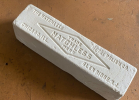I use 95% stabilized woods. I never apply a finish.
Sand to 400 grit or higher (I often do 1000() and buff on a clean cotton buff with matchless white rouge.
My non-stabilized woods are mostly very hard wood like ebony, blackwood, gidgee, DI, etc. I sand them to 2500 grit and buff with a hard wax like Brix (usually no wax). You can hand buff or power buff.
The only "finish" I ever use is a CA finish, and that is only on special more porous wood handles like silver wire inlay in curly maple or a figured walnut. Nick Wheeler has a great tutorial on doing a really great CA finish.
The trick for a beautiful handle finish, regardless of the finish type you are using, is to have the finish IN the wood, not ON it. This is the same for a CA finish or any type of oil finish. Apply the finish and let it sit for a while ... then wipe it off. Let cure completely and sand back to the surface with very fine paper. Apply-wipe-cure-repeat. It may take as many as six to ten applications to completely fill the wood pores and grain and get a lustrous finish that is not built up on the surface.
If the surface dulls with wear a quick hand buff with a soft cloth usually restores it.
TIP:
The 3M polishing sheets are probably the best way to get a show winning handle finish and keep it looking good. They are color coded and range from 400 grit (green) to 8000 grit (white). They will last a long time and can be used until they are rags.
Sand to 1000 grit with regular AO papers and then to back to 400 with the 3M sheets.
Touch up is just a fast hand buff with the pink/mint/white sheets. I often include a pink sheet and buffing instructions with a fancy wood handled knife.
They are also great for hand finishing or touching up a blade. Especially one with a few tiny spots of rust or oxide. I use a few drops of clove oil (or any good knife oil) on a green or gray sheet and rub briskly. Clean off and buff with finer sheets as needed.
User notes- Put an X on the back of the sheets with a marker when they are new so you can tell which side has the abrasive. This is especially important with the white sheet, as it is nearly impossible to tell once used. Store them in a Ziplock bag to keep stray grinding and sanding grit from the shop off them (the come in a Ziplock bag usually).

